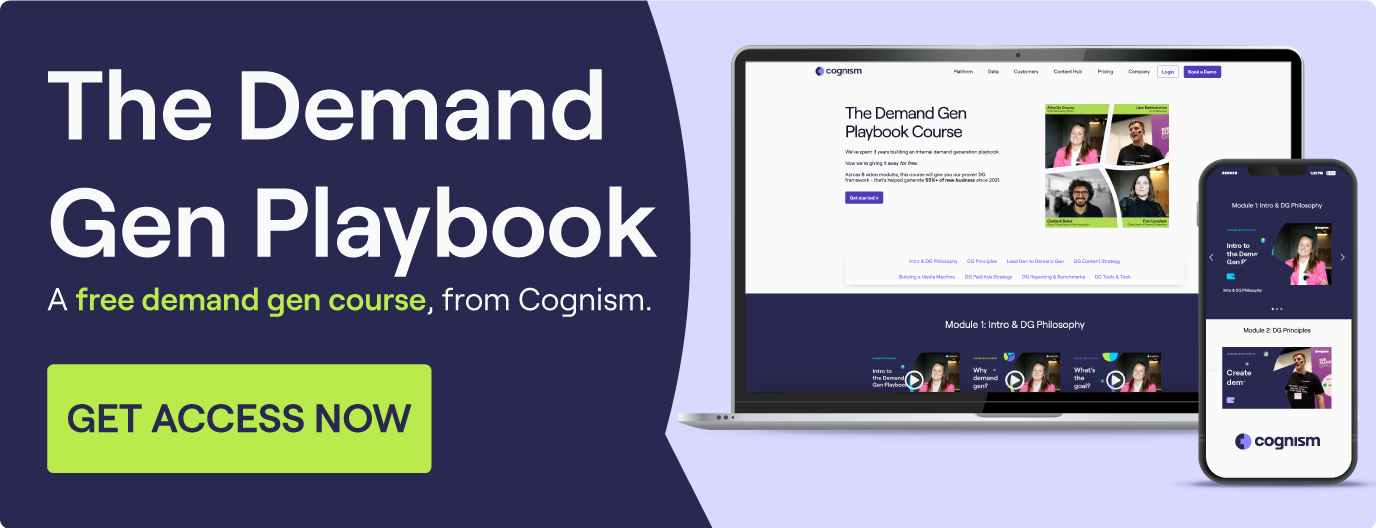20+ Best Demand Generation Tools We Tested
Demand generation is revolutionising the way businesses attract customers, and Cognism is leading this change. Under the leadership of our CMO, Alice de Courcy, Cognism has successfully transitioned from lead generation to demand generation.
Implementing innovative strategies supported by the latest software made this shift possible.
Join us as we delve into the top demand generation tools recommended by experts at Cognism and other leading demand gen first organisations.
1. Cognism Enrich: CRM data enrichment
Cognism Enrich is a must-have demand generation tech stack. It automates CRM data enrichment by updating account records and contact details.
It plugs into your existing tech stack, including Salesforce, Hubspot, Microsoft Dynamics, Outreach, and Salesloft, so you can send leads to your tools in two clicks.
Cognism’s B2B database has global coverage and is an unbeatable European contact database (emails and mobile numbers). It is also CCPA- and GDPR-compliant.
See Cognism Enrich in action - take an interactive tour 👇
Features
- Sales Companion (Web App): Access a vast database of contacts, companies, and buying signals.
- Sales Companion (Browser Extension): Access company and contact details on LinkedIn and other platforms.
- Diamond Data®: Phone-verified mobile numbers for B2B contacts.
- Intent data by Bombora: Identify companies researching topics relevant to your business.
- Cognism AI Search: Find prospects with ChatGPT-style text or voice prompts.
- Cognism Enrich: Instant and scheduled CRM enrichment and on-demand CSV enrichment.
- Seamless integrations with CRMs and sales and marketing tools.
- International coverage: EMEA, NAM, APAC.
- Fully GDPR and CCPA-compliant data.
- Database checked and cleaned against global DNC lists.
- Fast and friendly support team.
- Unrestricted access to person and company-level data (subject to fair use policy).
What Cognism’s customers say

CEO @Lead Forensics

Use case example
Instead of LinkedIn’s native targeting, the Cognism team uses Cognism to build a list of accounts overlaid with contextual data and then uploads it to LinkedIn as a matched audience.
Thanks to that, our campaign click-through rate jumped from 0.54% to 1.04%! That’s without changing the creatives, copy, or CTA.
Cognism allows you to filter by key purchase indicators such as hiring or funding.
For example, when targeting the logistics industry, Jamie Skeels, Cognism’s Senior Demand Generation Manager, filtered the list to target companies that use specific CRMs that Cognism integrates with. It allowed him to eliminate wasted budget from ABM campaigns.
Here is a step-by-step process for targeting specific verticals with LinkedIn Ads Jamie shares.
2. Gong: conversation intelligence
Another demand generation tool worth adding to your tech stack is Gong.io. It is a conversation intelligence platform that helps sales teams improve their performance by recording, transcribing, and analysing customer interactions. It uses AI to provide insights into sales calls, assisting teams to understand customer needs.
Features
- Call Recording and Transcription: Automatically records and transcribes sales calls.
- Custom Call Trackers: Analyses conversations to identify key concepts, i.e. objections, budget, and decision process.
- Integration: Integrates with CRM and other sales tools for seamless data sharing.
Use case example
You can use Gong.io to analyse sales calls and identify common objections. The demand gen teams can better understand customer pain points and define ICP by reviewing call transcripts and AI-generated insights.
Monika Kisielewska, SEO and Content Manager, recommends connecting Gong with Copy.ai to quickly source ideas for blogs from sales call transcripts and identify topics relevant to a specific ICP.
3. Wynter: customer research and messaging
Wynter is a must-have tool in your demand generation tech stack if you want to conduct qualitative research. The platform facilitates customer feedback through surveys, interviews, and focus groups, providing actionable insights for messaging refinement. It helps validate messaging and optimise marketing strategies.
Features
- Qualitative Research: Conducts surveys, interviews, and focus groups with your target audiences.
- Message Validation: Tests and validates marketing messages with real customers.
- Insight Reports: Generates reports with actionable recommendations based on research findings.
Use case example
Fran Langham, Global Head of Demand Generation at Cognism, has used Wynter to gather feedback on the new homepage and messaging and develop a narrative that resonates with our ideal audience.
4. Storylane: interactive product demos
Storylane is a platform for creating and managing interactive product demos. Demand gen teams use it to build engaging, no-code, self-guided product demos that allow potential customers to explore product features at their own pace.
Features
- Interactive Demos: Create clickable video, screenshot and HTML demos showcasing product features.
- Buyer Personalisation: Customise demo content with multi-flow demos and branching logic.
- Buyer Reveal: Identify and enrich data on anonymous companies engaging with your demos
- Demo Hub: Centralise your demos for easy access, management, and buyer education.
- Analytics: Track user interactions within demos for insights.
Use case example
At Cognism, we use Storylane to create interactive demos, like the one we embedded above, on our landing pages.
We want potential customers to experience Cognism's platform features firsthand before requesting a full demo. With the interactive demos, we've seen better user engagement and increased demo requests. Storylane demos effectively engaged leads and help us convert them into customers.
5. Chilli Piper: scheduling and meeting automation
Chili Piper enables leads to quickly trigger a call with sales reps or schedule it for later without going back and forth over email. This demand generation software also ensures lead routing to the right rep. It integrates with calendars to offer real-time availability and automates scheduling workflows to improve efficiency.
Features
- Calendar Integration: Syncs with Google Calendar and Outlook for real-time availability.
- Automated Scheduling: Offers self-service booking and eliminates back-and-forth emails.
- Routing Rules: Routes leads to the right sales reps based on predefined criteria.
- Analytics and Reporting: Tracks meeting metrics, i.e. cancellation rates, and performance analytics.
Use case example
If you rely on manual spreadsheets for scheduling, this B2B demand generation software will be revolutionary. It integrates with Salesforce so you can centralise inbound and outbound meetings. Marketing and sales teams use this tool to increase conversion rates from discovery to demo and contribute significantly to ARR growth through enhanced meeting management and lead nurturing capabilities.
6. HotJar: website user behaviour analysis
HotJar is a tool for demand gen teams seeking insights into visitor behaviour. It provides heatmaps, session recordings, and feedback polls to help businesses understand how users interact with their websites and identify opportunities for optimisation.
Features
- Heatmaps: Visualises user clicks, taps, and scrolling behaviour on web pages.
- Session Recordings: Records user sessions to replay and analyse navigation patterns.
- Feedback Polls: Collects user feedback and surveys to gather insights.
- Conversion Funnel Analysis: Tracks user journeys and identifies drop-off points.
Use case example
At Cognism, we use HotJar to optimise the website for better user experience and conversion rates. For example, Ilse Rensburg, Cognism SEO Content Manager, uses this platform to watch session recordings and analyse heatmaps on competitor pages. Based on the findings, she can test engagement with different modules, such as video, graphics, and interactive product walk-throughs.
7. Unbounce: landing page builder
Unbounce is a landing page builder that enables marketers to create and optimise landing pages without coding. It offers customisable templates, A/B testing tools, and conversion tracking to maximise lead generation and campaign performance.
Features
- Drag-and-Drop Builder: Easily create landing pages with a user-friendly interface.
- A/B Testing: Tests different page variants to optimise conversion rates.
- Conversion Tracking: Measures performance metrics like clicks, conversions, and bounce rates.
- Integration: Integrates with CRM and marketing automation platforms for lead capture.
Use case example
Janik Zeh, Senior Account Strategist at YOYABA, uses Unbounce in paid campaigns, especially in tandem with Microsoft Clarity.
Janik uses Unbounce’s various pre-designed templates to create landing pages for client campaigns and then sets up A/B tests to achieve clients’ growth. Microsoft Clarity is a free alternative to Hotjar and enables Janik to analyse user behaviour of paid traffic to landing pages and optimise content placement.
By combining insights from these two demand generation tools, Janik increased conversion rates by 400% for one client project!
8. Survicate: customer feedback and survey
Survicate is a platform for creating and distributing surveys to gather customer feedback and insights. It offers customisable survey templates, analytics tools, and respondent targeting options for actionable feedback collection.
Features
- Survey Creation: Builds surveys with a variety of question types and templates.
- Response Analysis: Analyses survey responses in real-time with customisable dashboards.
- Audience Targeting: Targets specific demographics and segments for feedback.
- Integration Options: Integrates with CRM and marketing automation platforms.
Use case example
GetResponse uses Survicate to analyse both quantitative and qualitative feedback. Abby Hehemann, Director of Product Marketing at GetResponse, says the tool helps them gain insights on acquiring new customers based on who their happy customers are and how to keep existing customers happy.
9. Dreamdata: revenue attribution and analytics
Dreamdata is a tool that supports demand generation by attributing revenue between the different teams involved in customer journeys. With that tool, demand generation marketers can track and attribute revenue to their campaigns and evaluate their effectiveness. The platform uses multi-touch attribution modelling to assign value to touchpoint data across the funnel based on revenue impact.
Features
- Revenue Attribution: Tracks and attributes revenue to specific marketing channels and campaigns.
- Data Integration: Consolidates data from CRM, marketing platforms, and ad networks.
- Performance Dashboards: Provides real-time marketing analytics and customisable dashboards.
- Forecasting and Reporting: Generates reports on revenue trends and marketing performance.
Use case example
Relying on last-touch attribution in Google Analytics can be misleading in modern B2B organisations. Revenue is not the result of a single department; it’s all the departments’ efforts that matter. Adding tools like Dreamdata to your demand gen tech stack will help you understand where the demand comes from and what actions drive revenue.
10. Kaspr: LinkedIn contact finder
Kaspr is a demand generation app that helps users directly find B2B contact details such as phone numbers and email addresses from LinkedIn profiles. It integrates seamlessly with LinkedIn to streamline prospecting and lead management.
Features
- Contact Data Extraction: Access phone numbers and email addresses from LinkedIn profiles, lists, groups, and events.
- Integration: Sync data with tools like Salesforce, HubSpot, and Pipedrive.
- Lead Management: Manage and track leads within Kaspr’s web app, including task
Use case example
Elie Tordjman, Sr Account Executive, at Craft AI uses Kaspr to extract contact details from LinkedIn profiles and automate CRM data enrichment with accurate data. As a result of targeted outreach across multiple channels, his marketing efforts are more effective and engagement rates improved.
11. Buffer: social media management and analytics
Buffer is an AI demand gen app for social media management. It simplifies scheduling, publishing, and analysing social media content across various platforms. Marketers use it to maintain a consistent social media presence and analyse the performance of their posts.
Features
- Post Scheduling: Allows scheduling posts across multiple social media platforms.
- Analytics Dashboard: Provides insights into post performance, reach, and engagement.
- Content Calendar: Helps plan and organise social media content.
Use case example
Demand generation teams can use Buffer’s team collaboration features to save and brainstorm post ideas in a single hub or have AI generate new ones. Then, they can share content across different platforms.
12. Semrush: SEO and content marketing
SEMrush is an all-in-one SEO and content marketing platform that offers tools for demand generation, such as keyword research, competitive analysis, and content optimisation. It helps teams promote their ever-green campaigns and drive organic traffic.
Features
- Keyword Research: Identifies high-value keywords for SEO and content strategy.
- Competitive Analysis: Analyses competitors’ SEO strategies and performance.
- Content Optimisation: Provides recommendations to optimise content for SEO.
- Backlink Analysis: Monitors backlinks and identifies link-building opportunities.
Use case example
Cognism's SEO team uses it to enhance its online presence, conduct keyword research, and target relevant search terms. It also helps analyse competitors’ SEO tactics.
13. Mailchimp: email marketing automation
Mailchimp is an email marketing automation platform. Without it, designing, sending, and analysing email campaigns wouldn’t be possible. It offers valuable demand generation tools for audience segmentation, A/B testing, and performance tracking to optimise email marketing efforts.
Features
- Email Campaign Builder: Drag-and-drop editor for designing email campaigns.
- Audience Segmentation: Segments subscribers based on demographics and behaviour.
- Automation Workflows: Automates email sequences based on subscriber actions.
- Analytics and Reporting: Tracks open rates, click-through rates, and other metrics.
Use case example
For example, Cognism uses Mailchimp to run targeted email marketing campaigns, such as a re-engagement campaign to target leads who exited a sales cadence.
14. Goldcast: webinar and virtual event
Goldcast is a platform for hosting and managing webinars, virtual events, and online conferences. It provides tools demand gen teams use for registration, live streaming, and audience engagement, making it easy to deliver impactful virtual events.
Features
- Event Registration: Manages attendee registration and ticketing.
- Live Streaming: Hosts live webinars and virtual events with HD video and audio.
- Audience Interaction: Enables Q&A sessions, polls, and chat during events.
- Analytics Dashboard: Tracks attendee engagement and event performance metrics.
Use case example
Cognism uses it to host Demandism webinars and virtual workshops. We found it particularly useful for engaging participants with interactive features and analysing attendee feedback.
15. Terminus: account-based marketing
Terminus is an ABM platform that helps businesses target and engage key accounts through personalised marketing campaigns. It offers account segmentation, content personalisation, and ROI measurement features.
Features
- Account Segmentation: Identifies and prioritises target accounts for personalised outreach.
- Personalised Campaigns: Delivers tailored content and messages to key decision-makers.
- ROI Measurement: Tracks campaign performance and revenue attribution.
- Sales Alignment: Aligns marketing efforts with sales goals and account strategies.
Use case example
With this B2B demand generation software, companies going upmarket can identify, score and target enterprise accounts.
16. Segment: customer data platform
Segment is an example of a customer data platform. This demand generation software collects, integrates, and manages prospect data from various sources. It helps businesses create unified customer profiles and deliver personalised marketing experiences across channels.
Features
- Data Integration: Connects and centralises customer data from multiple sources.
- Audience Segmentation: Segments customers based on behaviour and preferences.
- Real-time Data Sync: Syncs data across platforms to maintain accuracy.
- Personalisation Tools: Enables targeted messaging and campaigns.
Use case example
B2C and B2B companies can use Segment to analyse customer behaviour, segment audiences, and deliver personalised product recommendations and promotions to improve conversion rates.
17. Squadcast: recording and editing podcasts
If podcasts are part of your demand generation strategy, check out Squadcast and Descript. These two demand generation tools allow for recording and editing high-quality podcasts and videos. Squadcast ensures clear audio and video recordings, while Descript offers powerful editing capabilities to produce polished content quickly.
Features
- High-Quality Recording: Squadcast uploads clear audio and video during recording.
- Easy Transitions: Smoothly adds transitions, intros, and outros.
- Editing Templates: Descript allows the creation of templates for consistent editing.
- Multichannel Repurposing: Facilitates content repurposing for various platforms.
Use case example
Cognism team produces a weekly podcast for marketers In the Loop. Squadcast is great for recording and Descript for editing episodes. The tools help repurpose the recording into multiple content types, including YouTube videos, articles, and social media posts, all from a single recording session.
18. Claude.ai: AI demand gen tools
Claude.ai and ChatGPT are AI tools that assist in repurposing content across multiple channels. They analyse transcripts, extract key points, and suggest engaging titles and section headers, significantly speeding up the content creation process.
Features
- Content Analysis: AI tools analyse podcast transcripts for key quotes and points.
- Title and Header Suggestions: Provides catchy and relevant suggestions.
- Content Transformation: Converts insights into various content formats.
- Consistency Maintenance: Ensures content quality and brand consistency.
Use case example
Claude.ai and ChatGPT are being adopted as AI demand generation tools for quick and easy content repurposing. They help extract podcast highlights, suggest engaging headers, and enable the team to efficiently create blog posts, social media snippets, and other content while maintaining a consistent brand voice.
19. UserEvidence: customer evidence and research
UserEvidence is a tool designed to help businesses collect, manage, and showcase happy customers’ feedback and testimonials. It gathers authentic user reviews, case studies, and success stories to enhance a company’s credibility and marketing efforts.
Features
- Automated Feedback Collection: UserEvidence reduces the manual effort in collecting testimonials and reviews.
- Customisable Testimonial Requests: Businesses can tailor the requests for feedback or testimonials to suit their branding and specific needs.
- Showcase and Sharing Tools: Displays collected testimonials on websites, social media, and other marketing channels.
Use case example
Karin O’Grady, Global Head of Customer Marketing at Cognism, uses UserEvidence to customise the feedback requests to highlight specific features of a recently launched product Cognism Enrich. It helped build credibility and upsell the product.
20. Canva: creative demand gen tool
Canva is a versatile design tool for quickly creating visually appealing content. It offers customisable templates for various types of content, ensuring brand consistency and high-quality visuals.
Features
- Customisable Templates: Provides a wide range of design templates.
- Brand Consistency: Maintains consistent branding across all designs.
- Easy to Use: User-friendly interface for quick content creation.
- Multichannel Designs: Supports designs for different content types.
Use case example
Marketing teams with little design experience use Canva to create engaging visuals for their content. They utilise pre-built templates to quickly design YouTube thumbnails, blog post covers, and social media graphics.
Cognism’s demand generation playbook
We’ve spent three years building an internal demand generation playbook, and now we’re giving it away for free.
This course, which consists of 8 video modules, will give you our proven DG framework, which has helped generate 55%+ of new business since 2021. 👇




